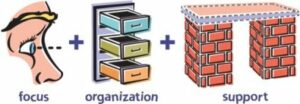Outlining a Response to an Essay Test Item
Writing a response to an essay test item is quite different from writing an essay when you have days or even weeks to plan, research, review, and revise your work. Your response to an essay test item must be written on the spot and within a short period of time. The item is based on what you’ve learned about the course topics, rather than a topic of interest which you select. Successful essay responses have three things in common: focus, organization, and support.
The key to writing a good response to an essay test item is to construct an outline for your response. Begin by reading the essay item carefully. Underline the key words and make sure you know exactly what you’re being asked to do. Then construct an outline as follows. The number of main points to be covered and the number of supporting details for each will vary depending on the specific item.

- Introduction
- Background information that provides context for your response. This is where you’ll demonstrate your general knowledge of the topic. Try not to exceed three sentences.
- A statement that includes the main points you will cover in your response. Three main points is usually sufficient.
- Main point one
- A topic sentence that introduces the first main point.
- Supporting detail that provides evidence for this main point.
- Supporting detail that provides evidence for this main point.
- Supporting detail that provides evidence for this main point.
- Main point two
- A topic sentence that introduces the second main point.
- Supporting detail that provides evidence for this main point.
- Supporting detail that provides evidence for this main point.
- Supporting detail that provides evidence for this main point.
- Main point three
- A topic sentence that introduces the third main point from the thesis.
- Supporting detail that provides evidence for this main point.
- Supporting detail that provides evidence for this main point.
- Supporting detail that provides evidence for this main point.
- Conclusion
- Synthesize your points to draw a conclusion.
Once you have constructed your outline, go through it and ask yourself the following questions. Is each of your main points directly related to what is being asked on the test item? Have you provided sufficient supporting details for each of your main points? Is everything in your outline necessary to respond to the item? Have you omitted any main points or details? You want to be sure that your outline is tightly focused on what is being asked in the test item.
Once your outline is completed, consider how you want to organize your ideas when writing your response. Do you want to order your ideas chronologically? In order of importance? In order of complexity? Once you’ve decided on your organization strategy, consider which transitional words and phrases you’ll use to move from one paragraph to another. Transitions will help your teacher understand your thought process and follow the essay. Remember that your teacher must understand what you’re saying and why you’re saying it in order to give you maximum credit for your response.
Creating a strong and focused outline is actually the hardest part of responding to an essay test item. If your outline is well-developed, writing your response will be relatively easy. In general, about half your time should be spent writing your outline, and the other half to expanding the outline into a full written response. Try to reserve a little to proofread your response for possible errors in writing mechanics.
Writing a good outline is the key to writing a good response to an essay test item.
